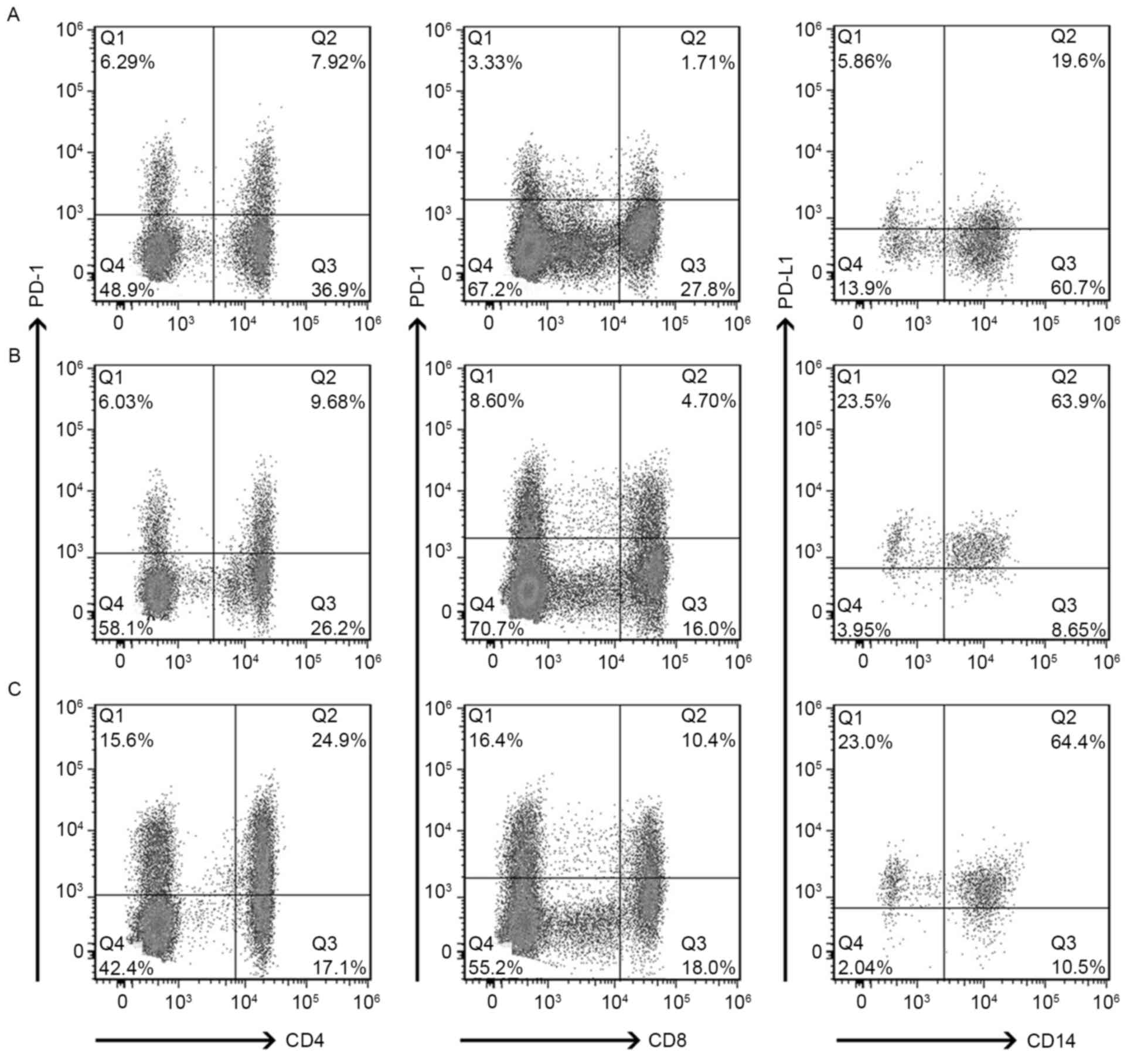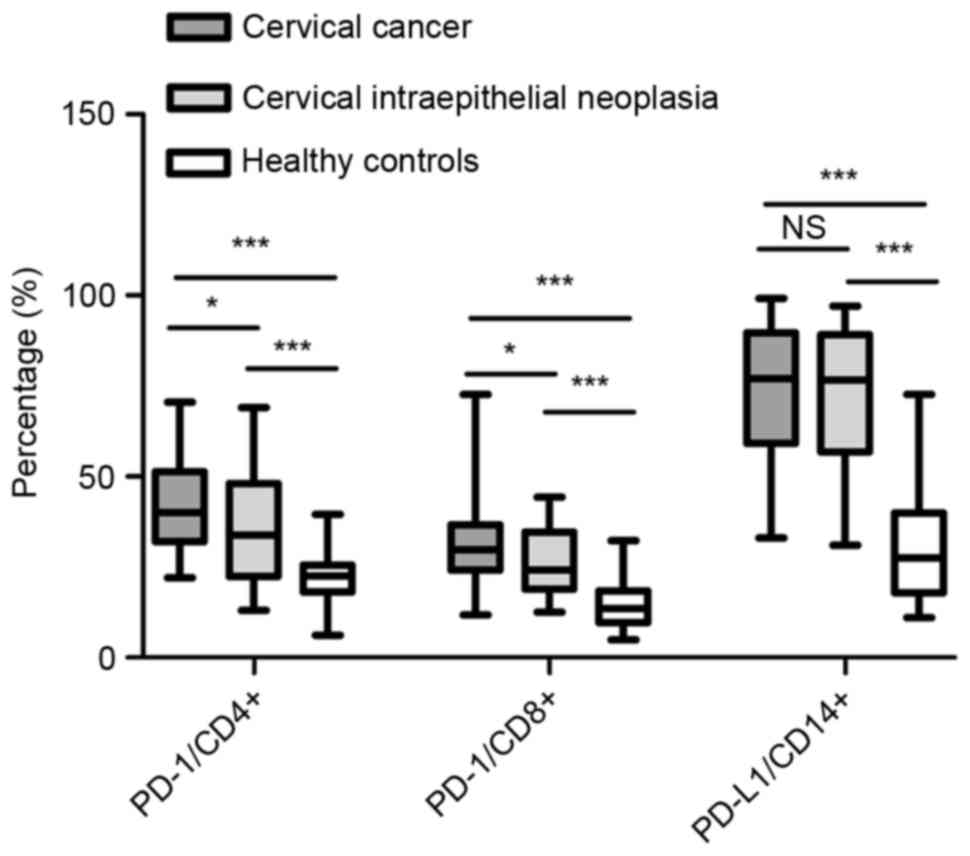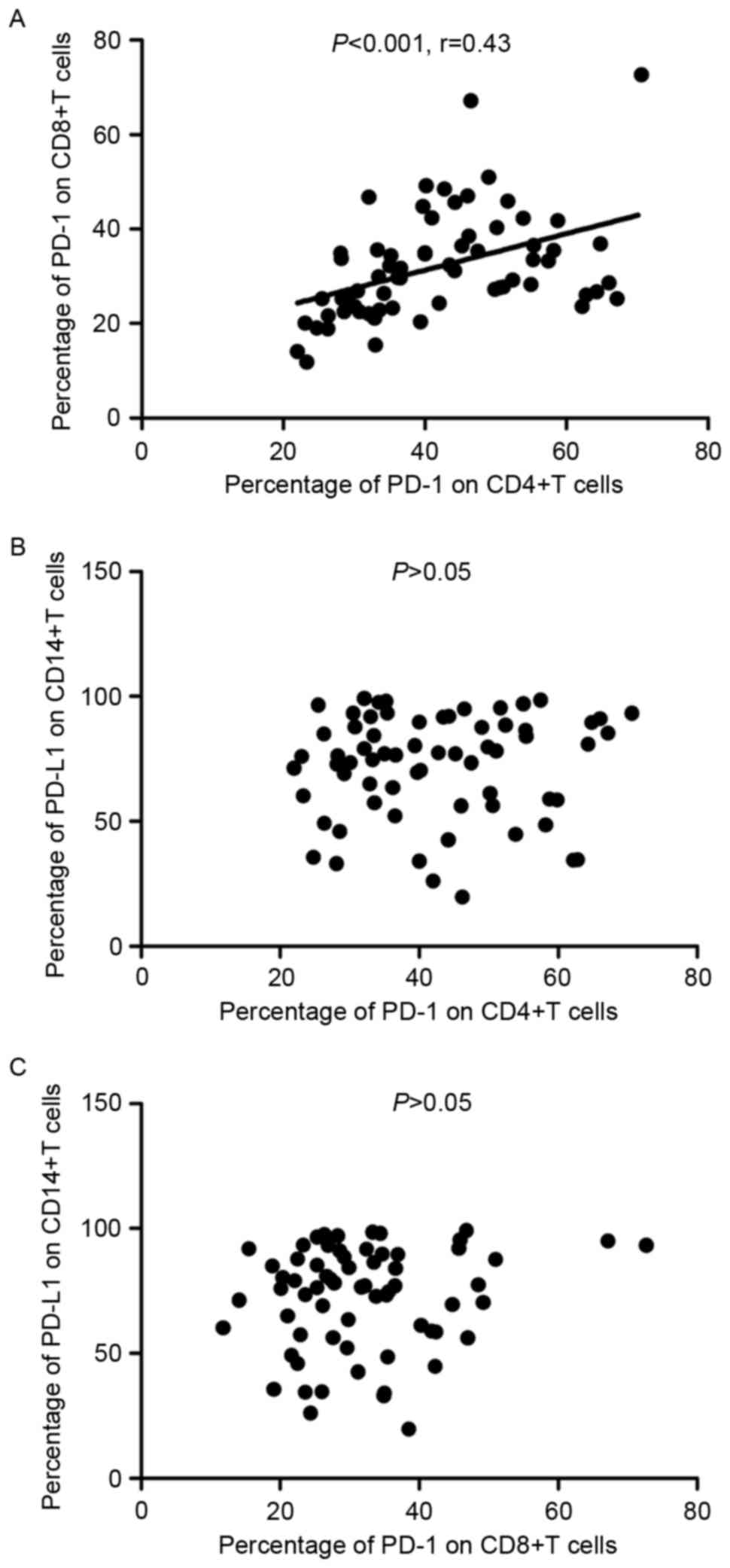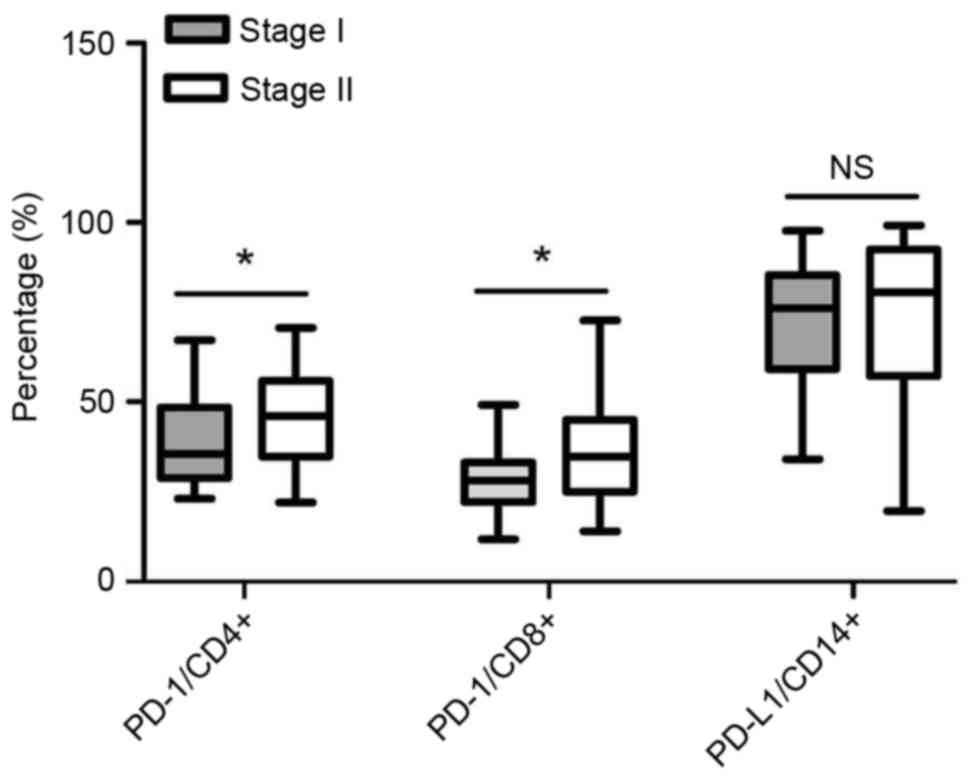|
1
|
Parkin DM, Bray F, Ferlay J and Pisani P:
Global cancer statistics,2002. CA Cancer J Clin. 55:74–108. 2005.
View Article : Google Scholar : PubMed/NCBI
|
|
2
|
Nedergaard BS, Ladekarl M, Nyengaard JR
and Nielsen K: A comparative study of the cellular immune response
in patients with stage IB cervical squamous cell carcinoma Low
numbers of several immune cell subtypes are strongly associated
with relapse of disease within 5 years. Gynecol oncol. 108:106–111.
2008. View Article : Google Scholar : PubMed/NCBI
|
|
3
|
Zou W and Chen L: Inhibitory B7-family
molecules in the tumour microenvironment. Nat Rev Immunol.
8:467–477. 2008. View
Article : Google Scholar : PubMed/NCBI
|
|
4
|
Barber DL, Wherry EJ, Masopust D, Zhu B,
Allison JP, Sharpe AH, Freeman GJ and Ahmed R: Restoring function
in exhausted CD8 T cells during chronic viral infection. Nature.
439:682–687. 2006. View Article : Google Scholar : PubMed/NCBI
|
|
5
|
Keir ME, Butte MJ, Freeman GJ and Sharpe
AH: PD-1 and its ligands in tolerance and immunity. Annu Rev
Immunol. 26:677–704. 2008. View Article : Google Scholar : PubMed/NCBI
|
|
6
|
Topalian SL, Hodi FS, Brahmer JR,
Gettinger SN, Smith DC, McDermott DF, Powderly JD, Carvajal RD,
Sosman JA, Atkins MB, et al: Safety, activity and immune correlates
of anti-PD-1 antibody in cancer. N Engl J Med. 366:2443–2454. 2012.
View Article : Google Scholar : PubMed/NCBI
|
|
7
|
Ohigashi Y, Sho M, Yamada Y, Tsurui Y,
Hamada K, Ikeda N, Mizuno T, Yoriki R, Kashizuka H, Yane K, et al:
Clinical significance of programmed death-1 ligand-1 and programmed
death-1 ligand-2 expression in human esophageal cancer. Clin Cancer
Res. 11:2947–2953. 2005. View Article : Google Scholar : PubMed/NCBI
|
|
8
|
Ghebeh H, Mohammed S, Al-Omair A, Qattan
A, Lehe C, Al-Qudaihi G, Elkum N, Alshabanah M, Bin Amer S, Tulbah
A, et al: The B7-H1 (PD-L1) T lymphocyte-inhibitory molecule is
expressed in breast cancer patients with infiltrating ductal
carcinoma: Correlation with important high-risk prognostic factors.
Neoplasia. 8:190–198. 2006. View Article : Google Scholar : PubMed/NCBI
|
|
9
|
Thompson RH, Kuntz SM, Leibovich BC, Dong
H, Lohse CM, Webster WS, Sengupta S, Frank I, Parker AS, Zincke H,
et al: Tumor B7-H1 is associated with poor prognosis in renal cell
carcinoma patients with long-term follow-up. Cancer Res.
66:3381–3385. 2006. View Article : Google Scholar : PubMed/NCBI
|
|
10
|
Maine CJ, Aziz NH, Chatterjee J, Hayford
C, Brewig N, Whilding L, George AJ and Ghaem-Maghami S: Programmed
death ligand-1 over-expression correlates with malignancy and
contributes to immune regulation in ovarian cancer. Cancer Immunol
Immunother. 63:215–224. 2014. View Article : Google Scholar : PubMed/NCBI
|
|
11
|
Komura T, Sakai Y, Harada K, Kawaguchi K,
Takabatake H, Kitagawa H, Wada T, Honda M, Ohta T, Nakanuma Y and
Kaneko S: Inflammatory features of pancreatic cancer highlighted by
monocytes/macrophages and CD4+ T cells with clinical impact. Cancer
Sci. 106:672–686. 2015. View Article : Google Scholar : PubMed/NCBI
|
|
12
|
Saito H, Kuroda H, Matsunaga T, Osaki T
and Ikeguchi M: Increased PD-1 expression on CD4+ and CD8+ T cells
is involved in immune evasion in gastric cancer. J Surg Oncol.
107:517–522. 2013. View Article : Google Scholar : PubMed/NCBI
|
|
13
|
Zhao J, Pan X, Xing Y, Lu M, Chen Y and
Shi M: Effects of soluble programmed death ligand 1 on regulating
the proliferation of T lymphocytes and its mechanism. Zhonghua Yi
Xue Za Zhi. 95:449–452. 2015.(In Chinese). PubMed/NCBI
|
|
14
|
Xing YF, Zhang ZL, Shi MH, Ma Y and Chen
YJ: The level of soluble programmed death-1 in peripheral blood of
patients with lung cancer and its clinical implications. Zhonghua
Jie He He Hu Xi Za Zhi. 35:102–106. 2012.(In Chinese). PubMed/NCBI
|
|
15
|
Gangadhar TC and Salama AK: Clinical
applications of PD-1-based therapy: Afocus on pembrolizumab
(MK-3475) in the management of melanoma and other tumor types. Onco
Targets Ther. 8:929–937. 2015.PubMed/NCBI
|
|
16
|
Karim R, Jordanova ES, Piersma SJ, Kenter
GG, Chen L, Boer JM, Melief CJ and van der Burg SH: Tumor-expressed
B7-H1 and B7-DC in relation to PD-1+ T-cell infiltration and
survival of patients with cervical carcinoma. Clin Cancer Res.
15:6341–6347. 2009. View Article : Google Scholar : PubMed/NCBI
|
|
17
|
Heeren AM, Kenter GG, Jordanova ES and de
Gruijl TD: CD14+ macrophage-like cells as the linchpin
of cervical cancer perpetrated immune suppression and early
metastatic spread: A new therapeutic lead? Oncoimmunology.
4:e10092962015. View Article : Google Scholar : PubMed/NCBI
|
|
18
|
FIGO Committee on Gynecologic Oncology:
FIGO staging for carcinoma of the vulva, cervix and corpus uteri.
Int J Gynaecol Obstet. 125:97–98. 2014. View Article : Google Scholar : PubMed/NCBI
|
|
19
|
Moniuszko M, Kowal K, Zukowski S,
Dabrowska M and Bodzenta-Lukaszyk A: Frequencies of circulating
CD4+CD25+CD127low cells in atopics are altered by bronchial
allergen challenge. Eur J Clin Invest. 38:201–204. 2008. View Article : Google Scholar : PubMed/NCBI
|
|
20
|
Riley JL: PD-1 signaling in primary T
cells. Immunol Rev. 229:114–125. 2009. View Article : Google Scholar : PubMed/NCBI
|
|
21
|
Wang Y, Xie C, Sun M, Chai J, Zhou Y, Chen
Y, Tang J and Li B: Expression and significance of PD-1 on CD4 (+);
and CD8 (+); T cells from the peripheral blood of patients with
systemic lupus erythematosus. Xi Bao Yu Fen Zi Mian Yi Xue Za Zhi.
29:962–965. 2013.(In Chinese). PubMed/NCBI
|
|
22
|
Su SS, He H, Kong LB, Zhang YG, Zhao SX,
Wang RQ, Zheng HW, Sun DX, Nan YM and Yu J: Regulatory phenotype,
PD-1 and TLR3 expression in T cells and monocytes from HCV patients
undergoing antiviral therapy: A randomized clinical trial. PLoS
One. 9:e936202014. View Article : Google Scholar : PubMed/NCBI
|
|
23
|
Rusak M, Eljaszewicz A, Bolkun L, Łuksza
E, Łapuć I, Piszcz J, Singh P, Dąbrowska M, Bodzenta-Łukaszyk A,
Kłoczko J and Moniuszko M: Prognostic significance of PD-1
expression on peripheral blood CD4+ T cells in patients with newly
diagnosed chronic lymphocytic leukemia. Pol Arch Med Wewn.
125:553–559. 2015.PubMed/NCBI
|
|
24
|
Yang W, Song Y, Lu YL, Sun JZ and Wang HW:
Increased expression of programmed death (PD)-1 and its ligand
PD-L1 correlates with impaired cell-mediated immunity in high-risk
human papillomavirus-related cervical intraepithelial neoplasia.
Immunology. 139:513–522. 2013. View Article : Google Scholar : PubMed/NCBI
|
|
25
|
Heeren AM, Koster BD, Samuels S, Ferns DM,
Chondronasiou D, Kenter GG, Jordanova ES and de Gruijl TD: High and
interrelated rates of PD-L1+CD14+
antigen-presenting cells and regulatory T cells mark the
microenvironment of metastatic lymph nodes from patients with
cervical cancer. Cancer Immunol Res. 3:48–58. 2015. View Article : Google Scholar : PubMed/NCBI
|
|
26
|
Rossille D, Gressier M, Damotte D,
Maucort-Boulch D, Pangault C, Semana G, Le Gouill S, Haioun C,
Tarte K, Lamy T, et al: High level of soluble programmed cell death
ligand 1 in blood impacts overall survival in aggressive diffuse
large B-Cell lymphoma: Results from a French multicenter clinical
trial. Leukemia. 28:2367–2375. 2014. View Article : Google Scholar : PubMed/NCBI
|


















